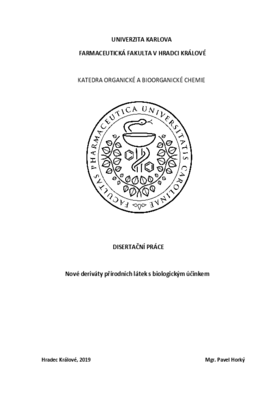Nové deriváty přírodních látek s biologickým účinkem
Synthesis and Biological Activity of Novel Natural Product Derivatives
dizertační práce (OBHÁJENO)

Zobrazit/
Trvalý odkaz
http://hdl.handle.net/20.500.11956/108054Identifikátory
SIS: 153149
Kolekce
- Kvalifikační práce [6960]
Autor
Vedoucí práce
Oponent práce
Hampl, František
Miletín, Miroslav
Fakulta / součást
Farmaceutická fakulta v Hradci Králové
Obor
Bioorganická chemie
Katedra / ústav / klinika
Katedra organické a bioorganické chemie
Datum obhajoby
14. 6. 2019
Nakladatel
Univerzita Karlova, Farmaceutická fakulta v Hradci KrálovéJazyk
Čeština
Známka
Prospěl/a
V rámci této disertační práce bylo připraveno několik sérií 3,4-diarylfuranonů a 3,4-diarylfuranů analogických k přírodnímu kombretastatinu A-4 a k antifungálně aktivnímu 5-(acyloxymethyl)-3-(halofenyl)-2,5-dihydrofuran-2-onu, které byly podrobeny biologickému screeningu (antimikrobiální, antifungální, cytostatická a cytotoxická aktivita). Dále byla u těchto sloučenin sledována schopnost aktivace kaspáz 3 a 7. Zajímavý profil cytotoxické aktivity byl nalezen u některých halogenovaných derivátů, např. 3-(3,4-dichlorfenyl)-4-(4- methylfenyl)-2,5-dihydrofuran-2-on vykazoval hodnoty IC50 vůči většině testovaných linií 0,12-0,23 µM. U těchto sloučenin byla zároveň zaznamenána i vysoká aktivita vůči nemaligním lidským liniím. Zavedením hydroxymethylového fragmentu do C5 furanonového kruhu byla navíc u zkoumaných struktur objevena značná antibakteriální aktivita se selektivitou vůči G(+) bakteriím. Nejzajímavější látka z této série, 3-(4-bromfenyl)-5,5-bis(hydroxymethyl)-4-(4- methylfenyl)-2,5-dihydrofuran-2-on, vykazoval hodnoty MIC95 vůči linii Staphyloccocus aureus (ATCC 6538) po 24 h a 48 h 0,98 µM a 3,9 µM. Navíc, hydroxymethylace C5 furanonového kruhu kompletně blokuje cytotoxický efekt. V druhé části práce, zabývající se syntézou analogických pyrrolidinonů bylo provedeno testování...
Within the framework of this Thesis, several series of 3,4-diphenylfuranones related to both combretastatin A-4 and antifungal 5-(acyloxymethyl)-3-(halophenyl)-2,5-dihydrofuran-2-ones was prepared. Cytotoxic effects on a panel of cancer and normal cell lines as well as antiinfective activity were evaluated, and the data were complemented with tests for the activation of caspase 3 and 7. High cytotoxicity was observed in some of the halogenated analogues, eg. 3-(3,4-dichlorophenyl)-4-(4-methylphenyl)-2,5-dihydrofuran-2-one with IC50 0.12-0.23 µM, but the compounds were also highly toxic against non-malignant control cells. Interestingly, notable antibacterial activity indicating G(+) selectivity has been found in the 3,4-diarylfuranone class of compounds for the first time. Hydroxymethylation of furanone C5 knocked out cytotoxic effects (up to 40 µM) while maintaining significant activity against Staphylococcus strains in some derivatives. MIC95 of the most promising compound, 3-(4- bromophenyl)-5,5-bis(hydroxymethyl)-4-(4-methylphenyl)-2,5-dihydrofuran-2-one against S. aureus strain ATCC 6538 was 0.98 µM a 3.9 µM after 24 h and 48 h, respectively. Following synthesis of closely related pyrrolidinones, enantioselectivity of the key step (Seyferth-Gilbert homologation) was tested. A new conditions...
